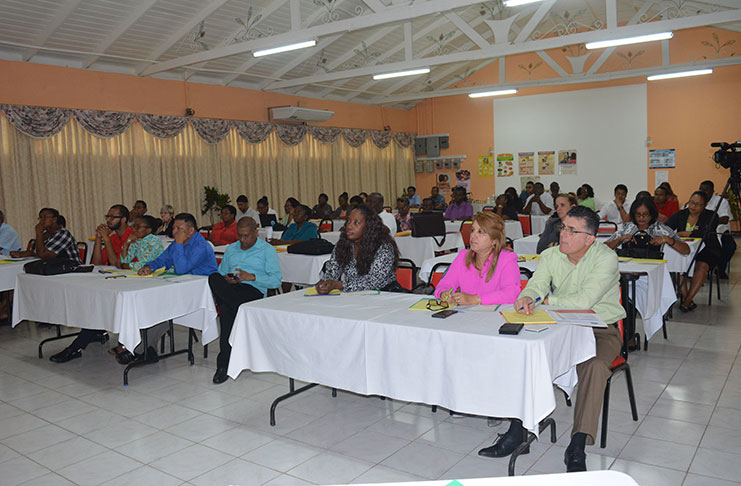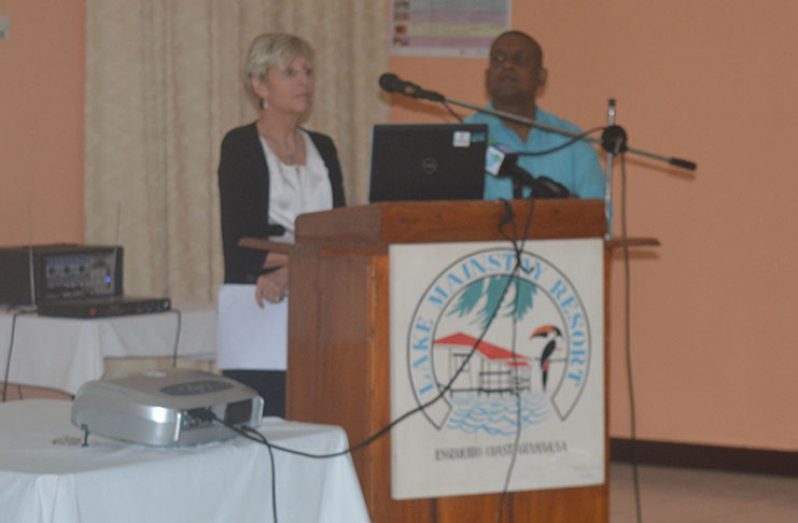– health authorities
FAR-FLUNG communities that are facing shortages of drugs and medical supplies because the distribution system has failed will soon have their supplies readily available as the Public Health Ministry collaborates with USAID to address the supply and distribution challenges.

Through a USAID Global Health Supply Chain Programme-Procurement and Supply Management (GHSC-PSM) Project, the Public Health Ministry is strengthening its capacity to develop sustainable systems to ensure availability and security of vital health commodities.
In painting a clear picture of the problem, Director of the Materials Management Unit (MMU) Cecil Jacques, during the Biannual Regional Health Officers Meeting on Wednesday at the Lake Mainstay Resort, pointed out that during a visit to Kamarang in the Cuyuni-Mazaruni District, Region Seven, in August, a box of medical supplies was sitting in the hospital there since July 14, 2017 for the health facility at Jawalla.
The box of much-needed medical supplies was ‘sitting’ in the Kamarang District Hospital for more than a month, although Jawalla is just three hours away by river.
Citing another example, Jacques said a team of health officials flew into Mahdia before departing to Kato and Paramakatoi, “and sitting at the Mahdia Airstrip were medicines for Kato.”
In expressing his frustration, the MMU Director said the Regional Democratic Councils (RDCs) must take responsibility. These councils comprise of [sic] Regional Health Committees, which are responsible for the administration of healthcare at the regional level.

“As soon as it hits the Mahdia airstrip, somebody must know that it is coming on this plane and as soon as it gets there, somebody must be able to pick it up and get it out where ever it has to go… somebody must be responsible for them,” Jacques told the regional health officers present.
Weighing in on the problem, GHSC-PSM Country Director Caroline Healey said distribution to the more than 350 health facilities across the regions is complex.
“The Ministry of Public Health doesn’t possess the capacity or the resources or the equipment to deliver commodities to all regions, so that is a major challenge,” Healey acknowledged.
In aiding the Public Health Ministry, regional authorities use different modes of transportation to transport the drugs and medical supplies to the various communities within their regions, but she said this is oftentimes done in an uncoordinated manner.
“It also means that there is a lack of coordination into the warehouse operations whether it is the MMU or Diamond,” she posited.
NECESSARY STEPS
However, she said the Public Health Ministry is conscious of the problem, and is taking the necessary steps to overcome those challenges.
It was pointed out that through the USAID-funded GHSC-PSM Project, the system is being reviewed with the aim of correcting its deficiencies.
Healey noted that last June, an analysis of the current distribution network for transportation and delivery of health commodities from central to health facilities was carried out.
The GHSC-PSM country director said it was found that Guyana has three unique segments for distribution. The regions are grouped into three segments based on their geographical locations, and as such, utilise different approaches to distribution.
She pointed out that Region One (Barima-Waini); Region Seven (Cuyuni-Mazaruni); Region Eight (Potaro-Siparuni); and Region Nine (Upper Essequibo-Upper Takutu) form part of segment one. These regions, Healey reminded, are hard to reach and in many cases more than one mode of transportation are required to distribute medical supplies at the community level.
Regions Two (Pomeroon-Supenaam); Three (Essequibo Islands-West Demerara); Six (East Berbice-Corentyne); and 10 (Upper Demerara-Upper Berbice) are part of Segment Two.
In this segment, the MMU distributes to major sites within each region and then staff in the region distribute from these major sites out to health facilities.
AD HOC MANNER
Healey said though Regions Four (Demerara-Mahaica) and Five (Mahaica-Berbice) are located in proximity to the MMU, their distribution of drugs and medical supplies appears to be done in an ad hoc manner.
“Segment Three (Regions Four and Five) has an ad hoc distribution pattern, disproportionally higher number of dispatches and uses a single mode of distribution,” she noted.
Since the assessment, Healey through the GHSC-PSM Project has made some key recommendations, including that of outsourcing for those regions grouped in Segment One.
“Basically we want to look at finding an organisation to manage and coordinate distribution on behalf of the ministry. We want to look at making sure that there are proper links in the distribution systems…. So if something arrives at the port, it just shouldn’t be sitting at the port, someone should organise to collect it,” she explained.
As part of the series of recommendations, Healey has advised the Public Health Ministry that roles and responsibilities should be clearly documented, and the key performance indicators should be determined.
For the second batch of regions, Healey said it has been recommended that it be clearly stated that who are the officials responsible for the distribution of drugs and medical supplies at the regional level and their roles and responsibilities. Standard Operating Procedures (SOP) must be clearly established, she emphasised. Similar recommendations were made for Regions Four and Five.
“We are very much behind the ministry in the need to develop a more efficient distribution system, particularly to look at outsourcing distribution, looking at contracting arrangements…,” the GHSC-PSM country director assured.



.jpg)










